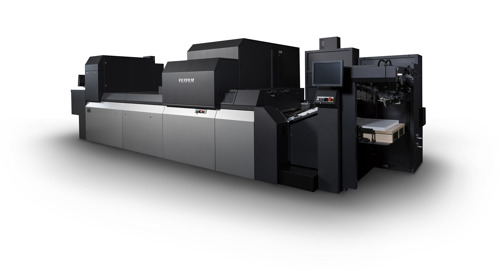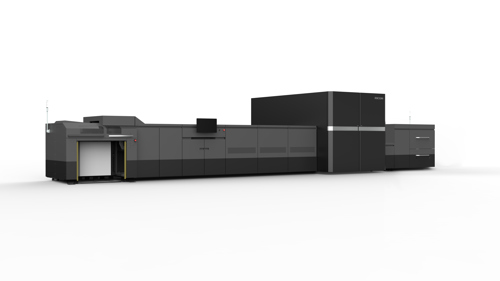That’s been true up to a point, although B2 litho presses are no longer the big sellers they once were, squeezed from below by SRA3 and now B2 digital, while the pressmakers have compelling arguments to move to larger formats for more efficiency.
For instance Murray Lock, joint MD at RMGT importer M Partners, says that the RMGT 920, an SRA1-format litho press, has captured a lot of what would previously have been B2 litho sales (a new 970 will be announced at Drupa). Compared with B1, he says, the RMGT SRA1 is more compact and uses less electricity. “We find that 86% of B1 printers only need SRA1,” he says. “We do still sell B2 too, but it’s a more difficult sell compared with SRA1.”
Erwin Busselot, business innovations and solutions director at Ricoh Europe, says: “Most B2 digital sales are seen as a vehicle to move from offset to digital. It’s now happening faster than we expected”. On the other hand he says, a price war in B1 offset sales has led to overcapacity, which he thinks may explain the relative failure of B1 digital to capture much of a market so far.
Ricoh has now introduced the Pro Z75 ‘Dragon’, a B2 inkjet press, as a step up from its SRA3 toner range. “We internally discussed B1 vs B2 vs B3 and decided B2 was the best opportunity,” says Busselot. First revealed in 2019 but only officially launched late last year, the Pro Z75 is a CMYK aqueous inkjet press with a top speed of 4,500sph. Unlike the rival Fujifilm Jet Press 7xx series it can automatically duplex and it has copier-style multiple feed trays.

Fujifilm Jet Press: the first B2 sheetfed inkjet was launched in 2008
Fujifilm, whose 2008 announcement of the Jet Press 720 was the first B2 sheetfed inkjet, has been steadily refining the design over the years. The 2018 750S was faster (3,600sph) thanks to a new IR drier, while the 2022 750HS introduced a slightly larger sheet size (750x662mm) for 6-up A4.
However, late last year Fujifilm also announced what may turn out to be one of the most interesting digital newcomers at Drupa, the first sheetfed B2 toner press, called Revoria GC12500. Although Xeikon introduced 500mm-plus B2-portrait web toner presses in 1997, only Fujifilm has managed a 750mm landscape configuration so far, with a 660mm length for 6-up A4s. The GC12500 will print 2,500sph CMYK on normal offset and copier stocks, with none of the inkjet issues about drying or special papers.
Fujifilm Europe’s product manager for digital press systems, Mark Stephenson, points out that it has twin feed trays online, and it will print duplex, unlike the Jet Press. “It’s a simpler press to operate, such as when getting paper in and out.” He says that operations and quality are the same as the long-SRA3 Revoria PC1120 (though without the two extra colours), though there is significant new donor and developer tech, with pre-heating and two-stage fusing to achieve an even image across the width. Pricing hasn’t been announced but is likely to be significantly less than a B2 inkjet or an HP Indigo.
Although Fujifilm was the first into the sheetfed digital B2 market, it has been HP Indigo that has been the biggest B2 seller since it announced its ‘wide-format’ (762mm) range of Indigo sheet- and web-fed liquid toner presses at Drupa 2012. Installations worldwide since then are 1,300-plus for the sheetfed configurations alone, while rival B2 presses only number at best a few hundreds each – Fujifilm says it has 300 Jet Presses operating worldwide.
The HP Indigo 120k is a new flagship 4/5 colour sheet-fed duplex press printing up to 6,000sph. This replaces the 100K introduced in 2022 with the same top speed but even more automation. Also new is the 18K, a 4/5/6/7 colour B2 workhorse all-rounder with a more pedestrian 3,450sph, but lots of automation including new AI help.

Ricoh Dragon: B2 assessed as the “best opportunity”
The 120K and 18K will use the familiar Indigo configuration of a multi-pass press with print units arranged around a large common blanket cylinder. But HP has a faster system in the wings, called LEPx. This has been used first on a narrow-web (340mm) label press called V12, with six two-colour print units inline along a transfer belt. It was announced last year and will ship at Drupa. The speed is an impressive 120m/minute (when printing six colours – half that for seven to 12), which is in the inkjet league. However, the press is long and pricing is unknown, though HP claims it will have “the earning power of multiple flexo presses”.
In the future, HP plans to introduce LEPx for wider flexible packaging webs, and ultimately for sheetfed commercial models; a calculator suggests 14,000 B2 sph might be possible.
Konica Minolta is persevering with its unique UV-cured B2 inkjet tech, first seen with the KM-1 at Drupa 2012, and improved as the AccurioJet KM-1e in 2020. At this year’s Drupa it’s introducing AccurioJet 60000, which will output 6,000sph, double the speed of the KM-1e. No other details have been announced so far.
The KM-1 was developed as a joint venture with Komori, which also sold it itself as the Impremia IS29, though neither saw significant take-up in the UK, apparently due to ink costs. At a pre-Drupa press conference Konica Minolta stressed that the 60000 doesn’t replace the KM-1e, but that Komori has not been involved in its development and will not be selling it. This press was only announced three weeks before the joint Fujifilm-Konica Minolta strategic development alliance was revealed, which may also have been a factor.
Digital B1 has had a rather fitful start, and only small numbers have reached actual users for carton and commercial work (digital corrugated is a different, comparatively successful market). One of the most impressive sights at Drupa 2016 was Heidelberg’s big Primefire 106, a B1 carton press mixing Fujifilm/Dimatix’s inkjet technology with the Speedmaster components. However, only a handful were delivered before Heidelberg did one of its periodic turnrounds on digital strategy, and dropped the Primefire and VLF analogue presses. It continued with its rebadged SRA3 Ricoh toner presses.
Primefire customers liked them, but are reportedly now having to retire them because they can’t buy the ink. Now Heidelberg is reportedly mulling getting back into digital again, though outgoing CEO Dr Ludwin Monz denied an interest in the B2 Ricoh Pro Z75.
Koenig & Bauer and Landa are the current main standard bearers for B1 digital. Koenig & Bauer’s 5,500sph VariJet 106 carton press is a joint venture with Durst, and mixes the former’s Rapida press expertise with the latter’s inkjet knowhow. VariJet is a modular design and can incorporate litho and flexo units inline with the inkjets. The configuration to be shown at Drupa will have seven inkjet colours plus three flexo units to add embellishment – gold, silver and white. So far two VariJets have been delivered, and a third is imminent.
Agfa is now joining them with its 11,000sph B1 Speedset 1060 Orca press, announced late last year with Delta Group later signing the first order. It has been developed by the former Inca Digital, which Agfa bought from Screen in 2022 and renamed Agfa Cambridge.
Orca is an aqueous ink CMYK printer with primer and two varnishing bars, suitable for paper, cartonboard and light corrugated. Agfa makes the ink and says it’s food-safe.
The 25m-long system is modular, with a Mabeg feeder and stacker, and Natgraph hot air dryer.

Landa S10 55 sold so far; S11 to be shown at Drupa
Benny Landa’s genius for publicity means most people will be aware of his Nanography digital press technology. This is essentially offset inkjet, able to print very bright colours on almost any substrate, from newsprint to plastics. Landa has been delivering steady numbers of the S10 simplex and S10P perfecting sheetfed B1 presses since the last Drupa – LDP says there are now 55 sales worldwide, half coming in the past year. A fifth have been second presses. Benny Landa says capacity is being ramped up to 100 presses per year.
This Drupa will see the introduction of faster S11/S11P sheetfed presses. Speed is up from 6,500 B1 sph to 11,200 – the ultimate target is 13,000sph – with up to seven colours. The main improvement is an IR drier for the transfer belt, says Landa, but it’s also “smarter” thanks to new AI.
Konica Minolta’s larger-format interests are concentrated on its associate MGI, whose huge 20tonne, €3m B1 AlphaJet will form the centrepiece of its Drupa stand. Alphajet is a 4,500sph four- or six-colour aqueous inkjet printer combined with inline high-build UV-cured inkjet varnishing, with massive and unique horseshoe shaped linear motor sheet transport system. So far the only commercial sale has been to ISRA in France, but KM hinted at a Drupa announcement.
To finish, with finishing, one puzzle is that there isn’t much being developed specifically for short-run on- demand B2 digital, unlike what happened for SRA3. For commercial print it seems the assumption is that you’ll just cut B2 in half and feed it into a booklet maker or multi-finisher. The exception is small carton work and posters where the number of digital friendly products are increasing and there will be announcements at Drupa. We’ll return to that topic in another issue.










